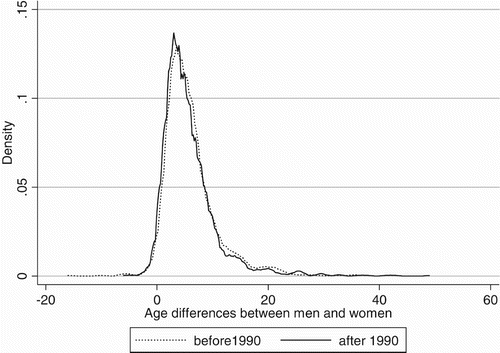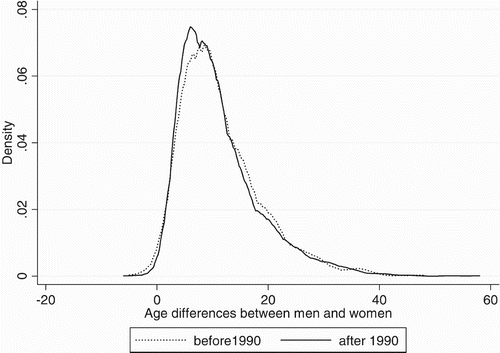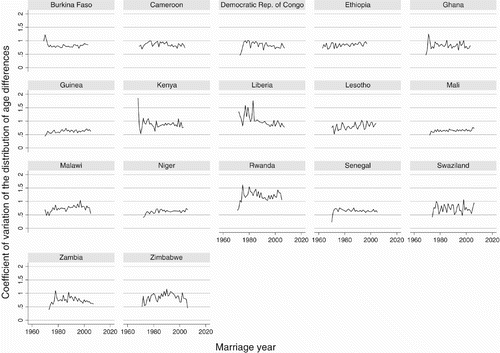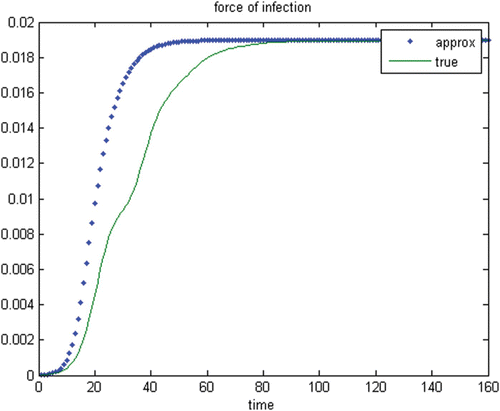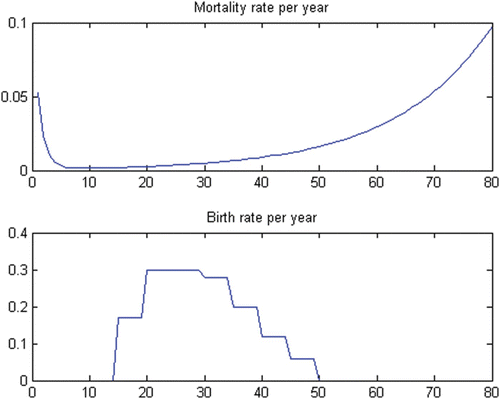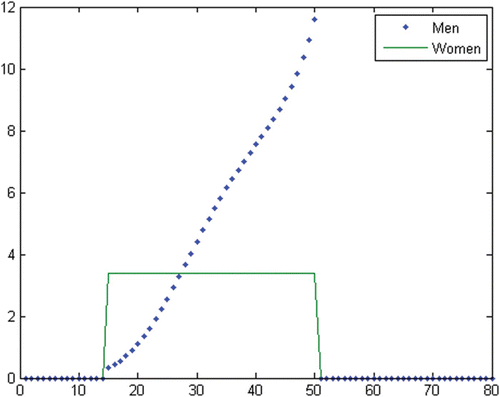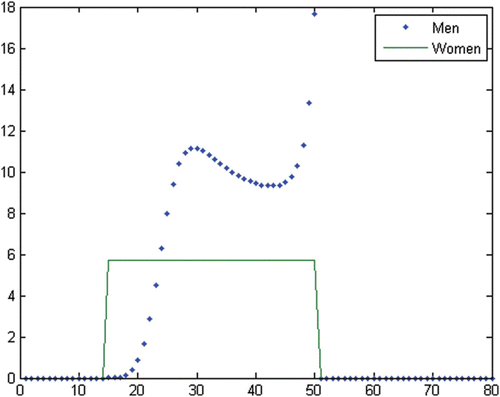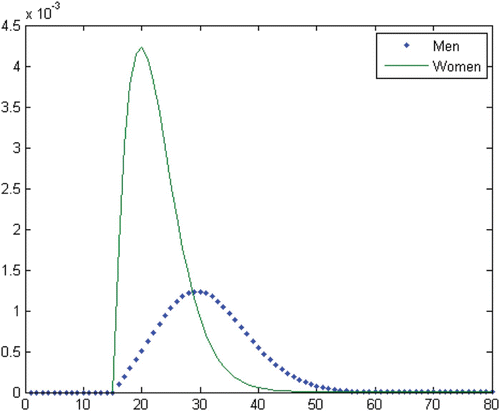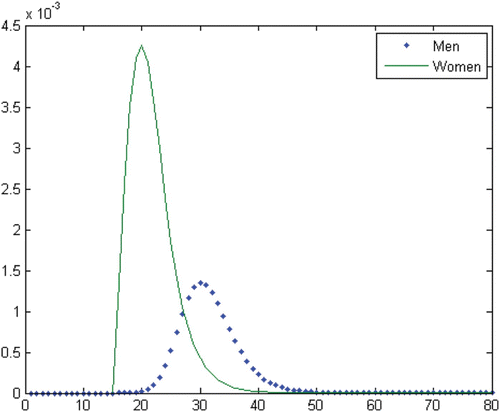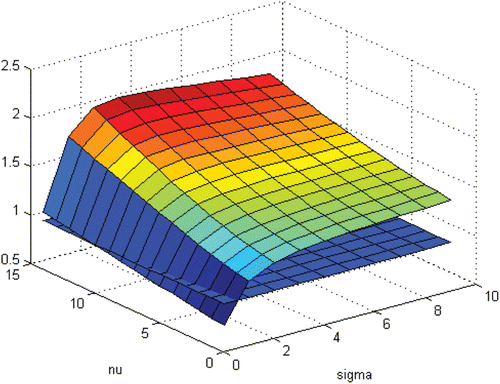Abstract
In this paper, the effect of a change in the distribution of age differences between sexual partners on the dynamics of the HIV epidemic is studied. In a gender- and age-structured compartmental model, it is shown that if the variance of the distribution is small enough, an increase in this variance strongly increases the basic reproduction number. Moreover, if the variance is large enough, the mean age difference barely affects the basic reproduction number. We, therefore, conclude that the local stability of the disease-free equilibrium relies more on the variance than on the mean.
Keywords:
1. Introduction
Thirty years after the discovery of the first confirmed clinical cases, the HIV epidemic is not yet under control. UNAIDS Citation28 estimates that worldwide 2.6 million adults and children were newly infected with HIV in 2009. The HIV epidemic affects Africa disproportionately, and especially sub-Saharan Africa, which accounts for 69% of the new infections (1.8 million in 2009, according to Citation28). This paper is concerned with a demographic explanation of the differences in the evolution of the epidemic that have been observed across the regions. More precisely, we study the effect of the distribution of age differences between sexual partners on the long-run dynamics of the epidemic and on its endemic nature.
The age mixing, or age differences, among marital partners is particularly widespread in Africa than in other parts of the world. Spijker Citation27 illustrated this pattern by providing statistics on the distribution of married couples by age differences using the most recent census data from the Integrated Public Use Microdata Series. In Africa, the proportion of couples having more than 8 years of age difference ranged from 22.5% (South Africa, 1996) to 80.3% (Guinea, 1996), while the same proportion ranged from 6% (China, 1990) to 26.2% (Malaysia, 1980) in Asia and from 17.5% (Chile, 1992) to 28% (Panama, 1990) in Latin America. A large amount of literature has documented the particular frequency of age mixing in sub-Saharan Africa. Historically, age mixing has been commonplace in Africa Citation9 as a result of practices such as polygamy, the remarrying of widows and the premature marrying of young girls. Studies have shown that nowadays age differences persist throughout AfricaFootnote1 within both marital and non-marital partnerships and within both casual and regular relationships Citation2 Citation14. It has been found that about 40–50% of young girls are involved in partnerships with a partner who is 5–9 years older than them Citation14 Citation19 Citation20. Greater age differences are also common as between 16% and 27% of young girls are in partnerships involving an age difference of 10 years or more Citation14 Citation19 Citation20. This age mixing can also be observed for older women as the majority of the married women aged 15–44 years studied in Citation5 had a husband who was at least 6 years older than them. Studying male non-marital unions, Luke Citation23 found that 70% of the sampled men were 5 or more years older than at least one of their recent partners and 20% were 10 years or older.
Grounded on the empirical evidence that the HIV prevalence rate is much greater among young women than among young men (e.g. Citation8 Citation12 Citation13), a growing body of research has examined age differences between partners as a potential risk factor of HIV infection. Some articles have documented the association between age difference between sexual partners and the increased risk of HIV infection Citation14 Citation19. The increase in risk is significant as documented by Kelly et al. Citation19, who found that 15–29-year-old women engaged in partnerships with a partner 5–9 years older or 10 years or older than them had a respective risk of infection of 1.1 and 1.28 times higher than their counterparts having partners 0–4 years older than them. Related papers have shown that people in partnerships involving large age differences are less likely to adopt safe practices than their counterparts, as women in long-term partnerships involving an age difference of more than 5 years Citation4 and men engaged in non-marital partnerships involving an age difference of 10 years or more Citation23 are less likely to use a condom than their counterparts.
The importance of age differences between partners in the diffusion and persistence of the epidemic was first brought up by Anderson et al. Citation1. Through numerical simulations, the authors showed that the epidemic spreads more rapidly when there is an infectious contact between generations. An intuition has been proposed by Brouard Citation6, who stressed the importance of the variance of the distribution. The latter could be one of the explanatory causes of a markedly higher prevalence of HIV in Africa. Whatever be the mean, if the variance is very low, one can imagine that there would only be minimal transmission of the virus from the first cohorts of a given gender to be affected by the epidemic to the younger cohorts of the same sex. Thus, the dynamics of HIV infection would be epidemic in nature. On the other hand, if there is a significant variance, the transmission of the disease to younger cohorts is potentially significant and hence the dynamics are likely to be endemic.
The objective of this paper is to propose a formal framework to evaluate the impact of the distribution of age differences between partners on the dynamics of the epidemics. We proceed in three steps. First, we seek to show that the distribution of age differences between sexual partners has not been modified by the emergence of HIV. This analysis is performed on a sample of African countries given the data constraint. However, one could argue that if such a scenario has prevailed, that is, if people have changed their matching preferences as a protective behaviour against HIV, it is much more likely to have occurred in the region that exhibits the highest levels of prevalence in the world. Using the distribution of age differences for married couples, we show that its mean and variance have not undergone significant variation over time.
Second, we use this preliminary evidence to establish a theoretical model in which the distribution of age differences between partners is exogenous to the path of the epidemic. Our model, which is both age- and gender-structured, is an extension of Anderson et al.’s Citation1 framework, which allows us to take into account the unique nature of epidemics involving sexually transmitted diseases. We study the stability of the disease-free equilibrium (DFE). One important element of our model is the contact function that incorporates the distribution of age differences between partners. Unlike most models in the literature, our function is necessarily non-separable, which makes it impossible to calculate the basic reproduction number, R 0, explicitly. Nevertheless, using the operators theory, we are able to establish the local properties as well as some global properties of R 0.
Finally, we assume that the distribution of age differences between partners is characterized by a given distribution and we analyse the effect of both the mean and the variance on R 0. Numerical computations show that the variance plays a crucial role as R 0 strongly increases with the variance if it is sufficiently low. Moreover, if the variance is large enough, the mean age difference barely affects R 0. We conclude that, whatever be the mean age difference, the DFE will thus have a greater chance of being stable if the variance is small.
The paper is organized as follows. In Section 2, we present our empirical evidence. In Section 3, we describe the dynamic model, and in Section 4, we present our theoretical results. In Section 5, we develop and comment upon our numerical results. In Section 6, we give the conclusions.
2. Empirical evidence
In this section, we examine the distribution of age differences between spouses, especially the evolution of its mean and variance over time. In industrialized countries such as Sweden, the average age difference has been found to be stable among the cohorts born between 1883 and 1942, despite a decrease in the age at marriage Citation3. In sub-Saharan Africa where the epidemic has reached tremendously high levels and where the age difference has been pointed out as a risk factor of HIV infection, one might wonder whether individuals have adjusted their behaviour towards a reduction in the age difference since the onset of the epidemic as a self-protective mechanism. The data collected from the Demographic and Health SurveysFootnote2 conducted in sub-Saharan Africa suggest that this scenario is very unlikely.
In order to determine whether the AIDS epidemic has changed matching behaviours and shifted individuals’ preferences towards fewer age mixings, we used the distribution of age differences for married couples. As the time series of spousal age differences were not available, we obtained data from the self-reported age differences in the most recent Demographic and Health Surveys conducted in sub-Saharan Africa. In these surveys, women respondents currently married were asked to report their current age, the current age of their partner and the year in which they got married. Given the spousal age difference and the marriage year, we were able to establish the empirical distribution of spousal age differences for each marriage year. The year in which the marriage took place was an indicator of the time period in which the individual made her decision about partner selection. Consequently, it provided more accurate information about individual behaviours than any cross-sectional analysis.
We restricted the sample to women who married when aged between 15 and 25 years for two reasons. First, it is the most common age interval at which women marry. In Lesotho, for instance, this sub-sample accounts for 90% of the total sample. Second, and more importantly, this sample restriction allowed us to rule out heterogeneities in the marital pattern from our analysis. Indeed, women who were married after reaching the age of 25 might have been previously married to someone else or might have different preferences in terms of partner selection compared with women who get married at a younger age.
To obtain a first indicator as to whether the spread of AIDS in Africa has induced changes in the choice of partner, we drew the distribution of spousal age differences for a low-prevalence and a high-prevalence country and for two distinct samples: women who married before 1990 and those who married after 1990. charts the empirical distributions for Lesotho, which is one of most affected countries in sub-Saharan Africa, since 23.6% of its adult population was HIV infected in 2009 Citation28. Similarly, charts the distributions for Niger, a country which has one of the lowest infection rates on the continent as its adult HIV prevalence rate reached 0.8% in 2009 Citation28.
Taking 1990 as a benchmark year, the two distributions were very similar, suggesting that there was no adjustment in the behaviour after the populations became informed about the HIV/AIDS epidemic and its ways of transmission.
The Demographic and Health Surveys are standardized nationally representative household surveys that collect data in various African countries based on a standardized questionnaire. We were thus able to generalize our analysis using a large set of countriesFootnote3 in order to test whether the distribution of the spousal age differences was constant over time.
We used the survey to compute the mean and the coefficient of variation of the distribution of the spousal age differences by country and by marriage year. and show the dynamics of the mean and the coefficient of variation,Footnote4 respectively, for each country of the sample.
There was no clear pattern suggesting a change in the distribution of the age differences over time, except for Ghana and Malawi, where a downward trend in the mean from the mid-1980s onwards could be observed. The mean of age differences decreased from 1985 in Ghana and from 1986 in Malawi, but these decreases were not statistically significant. If we go back to the individual data, and implement a t-test to test for the difference between the population mean of age differences in these years and at the end of the period, we find that in both cases, we cannot reject the null hypothesis that the population mean is equal in 1985 and in 2003 in Ghana (and in 1986 and in 2005 in Malawi).
To test the stability of the distribution of spousal age differences over time, we used a linear fixed-effects model to successively estimate the mean and the coefficient of variation of the spousal age differences at the country-year level using as independent variables the marriage year and a dummy variable that takes the value of one if the marriage took place before 1990 and zero otherwise. The empirical results presented in suggest that the marriage year and the act of getting married before the spread of the AIDS epidemic have no statistically significant effect on the dependent variables, that is, the mean (column 1) and the coefficient of variation (column 2).
Table 1. Linear fixed-effects estimates (in parentheses: robust standard errors, clustered at the country level).
These stylized facts suggest that controlling for country-specific effects, the distributions of spousal age differences are stable over time and that the onset of the epidemic disease does not imply any adjustment in preferences regarding the age difference between spouses. Therefore, grounded on this empirical evidence, in the next section, we consider the dispersion of age differences as an exogenous parameter of the model.
3. An age-structured mathematical model
3.1. The model
Our model can be seen as an extension of the model developed by Anderson et al. Citation1, which describes the spread of a sexually transmitted epidemic disease in a multi-group model. In our study, multi-group modelling was implemented due to the gender-specific variables used. Our main departure from the work of these authors lies in the definition of the boundary conditions that characterize the birth process. Indeed, we assume that the latter depends on sexual behaviours and that, as a consequence, it is intrinsically linked to the spread of the epidemic disease.
For each gender where f corresponds to the population of women, while m corresponds to the population of men, let S
g
(t, a) and I
g
(t, a) denote, respectively, the (chronological) age-specific density at time
of susceptible and infective individuals of age
, where ω>0 denotes the maximal length of life. Their dynamics are given by the following system of equations:
Before discussing the specific form of the force of infection, let us introduce some notations. Let denote the density of individuals of gender g and age a at time t. Using EquationEquations (1)
and Equation(2)
, we obtain
Let us note that we allow for time dependence in the average number of partners. More precisely, we assume that such a function can be characterized by the product of two functions: c
g
(t, a), the rate of partner change for an individual of age a and gender g at time t, and , a mixing function indicating, at time t, the probability that an individual of age a and gender g chooses a partner of age a′. It satisfies
. We hence have
Let us now describe the boundary conditions that characterize the birth process. Let b(a) be the probability of age a susceptible and infected women who have a sexual partner to give birth to a child. Furthermore, in order to simplify the model, assume that there is no vertical transmission of the disease (i.e. all children are born susceptible). Using the time independence assumption for , the boundary conditions read
In summary, the model that we considered consists of EquationEquations (1), Equation(2)
, Equation(6)
, Equation(7)
and Equation(8)
and initial data Equation(9)
.
3.2. A simplified model
In order to deal with the above age-structured model, we considered the possibility of an exponentially growing population. This was done due to the linear assumption on the demographic parameter. In the absence of disease, namely I g ≡ 0, the dynamics of the population is driven by the following linear age-structured system of equations given for each gender:
This remark allows us to formally simplify the epidemic system under consideration and especially EquationEquation (7). Indeed, if for each class of ages and each gender, the number of infective people I
g
(t, a) remains small with respect to the age-specific total number of individuals N
g
(t, a), then one obtains, at least for large t, that
This simplification was studied further and validated using numerical simulations as presented in the figures below. To perform the numerical investigations, we assume that the mixing function takes the following form:
Finally, our simplification allows us to deal with age-specific prevalence i
g
(t, a), to derive an expression for R
0 and to study its dependence with respect to various parameters. Let us also mention that our simplification has some information on the Malthusian parameter of the total population, namely parameter γ, and also on the sex-ratio parameters σ
g
. More specifically, using the above simplification and using the independent variables i
f
(t, a) and i
m
(t, a), the system that we will consider reduces by combining EquationEquations (3) and Equation(10)
to the following one:
4. Basic reproduction number
In this section, we derive some basic mathematical properties of EquationEquation (15) together with EquationEquations (6)
and Equation(14)
. The local dynamics are studied by analysing the spectral radius of a linear operator of a related system. The difficulty arises from the fact that in contrast to most papers in the literature, we do not assume the separability of the rates of infection. It is, therefore, not possible to derive an explicit expression for the spectral radius of the next-generation operator. However, spectral theory provides well-known tools to obtain the properties for the spectral radius. We establish some of its properties that will allow us, in the last part, to obtain some properties about the dynamics of some specified contact rate functions.
Because of the biological definition of i
g
, we introduce the following state Banach lattice spaces endowed together with the usual product norm as well as
Assumption 1
Assume that
and, for each
functions γ
g
belong to
.
As a consequence, Λ
g
defined above becomes a bounded linear operator . Next, the functional framework is defined as follows. Let us first recall that
is a Banach lattice partially ordered with its positive cone X
+ defined by
Lemma 1
Let Assumption 1 be satisfied. Then, the operator (A, D(A)) is the infinitesimal generator of a C
0
-positive semigroup
on X. There exists a unique strongly continuous semiflow
such that for each
the map
is a mild solution of system
Equation(19)
, that is,
Proof
The proofs of similar results can be found in Citation7 Citation11 Citation31. A key factor is given by the positivity of the semigroup generated by A, namely
Let us now study the local dynamics in the neighbourhood of the so-called DFE that corresponds to the stationary solution . We now prove that the linear stability of the DFE is related to the so-called basic reproduction number. The corresponding linearized equation around the DFE is given by
Theorem 1
The linear operator
is the infinitesimal generator of positive C
0
-semigroups
on X. We also have the fixed-point formulation:
Proof
It is easy to see that
Before establishing the local stability of the DFE, let us propose a formal definition of the basic reproduction number and make a remark.
Definition 1 (Basic reproduction number)
Consider the bounded linear operator T
0∈L(X) defined by
and define the following quantity:
Remark 1 One has the following explicit expression for operator T:
The next theorem establishes the local stability of the DFE.
Theorem 2
Let Assumption 1 be satisfied. Then, the DFE is locally asymptotically stable if R 0<1 and is unstable if R 0>1.
To prove Theorem 2, we present two lemmas. We first note that due to Theorem 1, the local stability of the DFE is related to the location of the real value s(Â+B) with respect to zero. Consider for each , the bounded linear operator
defined by
Lemma 2
For each
the operator T
λ
is positive and compact. Moreover, for each
one has
Proof
The positivity is obvious as well as the decreasing property with respect to λ (see, for instance Citation24). The compactness follows by the fact that for each , operator T
λ is regularizing in the sense that it maps the unit ball of X into a bounded set of
. ▪
Next, consider the map defined by
Lemma 3
Let Assumption 1 be satisfied. Then, the map
is continuous, decreasing and satisfies
Proof
Let us first note that the map is continuous from ℝ to
. Since T
λ is compact for each
we conclude that
is continuous. As a consequence, due to Lemma 2, the map
is decreasing. Then, it is easy to check that
A direct consequence of Lemma 3 is that if R
0<1, then , and if R
0>1, then s>0. This completes the proof of Theorem 2.
Let us conclude this section with a result on the existence of endemic equilibria.
Theorem 3
Let Assumption 1 be satisfied. If R
0>1, then system
Equation(1)
has at least one endemic stationary state, that is, there exist
such that
Proof
Let us recall that as R
0>1, there exists λ>0 such that . Let
be given such that
. Consider the following fixed-point problem now: find
such that
Since the operator
is positive and F is increasing, one obtains by setting e=(1, 1) that
5. The impact of the dispersion of age differences between partners
In this section, we numerically compute the value of the epidemic threshold, R 0, as a function of the mean and the variance of the distribution of age differences between partners.
5.1. Parameters and functions of the model
We simulated the model using parameters that were similar to those used in Citation1, including the age-specific mortality and fertility rates displayed in .
For mortality, which is supposed to be similar for men and women, we used the Siler approximation, which is a parametric function that may be used to fit mortality data and obtain that life expectancy at birth is 55.069 years. Concerning fertility, we obtained a total fertility rate of 7.15. The demographic growth rate of the disease-free population can be computed using the formula given in EquationEquation (12), and it was equal to
. Concerning the epidemiological parameters, we assumed that the infectiousness of the disease is age independent,
, and that a susceptible woman having a sexual contact with an infected man has a risk of infection which is three times higher than that observed in partnerships involving a susceptible man and an infected woman. The over-mortality rate of the infected individuals was also supposed to be age independent,
, and was set such that the life expectancy (ignoring other causes of death) was 5 years.
The parameters are given in .
Table 2. Parameters of the simulated model.
The mean rates of partner change per year as functions of age were considered at the endemic equilibrium. We used the mean values of ν and σ computed in our sample of African countries, namely ν=8.78 and σ=2.62. Concerning the parameter of function c f (a), we followed Anderson et al. Citation1 by using η=3.4 and η=5.7, as depicted in and , respectively.
Similarly, we computed the average prevalence at the endemic equilibrium as well as the age-specific prevalence for men and women. Using η=3.4 () and η=5.7 (), we found the prevalences to be equal to 1.5% and 5%, respectively.
Two notable features of these figures are that they indicate that (i) women are proportionally more infected than men and (ii) the mean age of the infected population is lower for women than for men. Both conclusions are consistent with the empirical evidence reported in previous studies (e.g. [Citation8,12,13, 28, Chapter 2]).
5.2. Numerical results
We performed numerical simulations to evaluate the effect of both the mean and the variance of the age differences on the basic reproduction number. The latter was computed as the exponential of the speed of divergence (or convergence) of linear system Equation(21). We computed the basic reproduction number as a function of the mean age difference, ν, and the standard deviation, σ, using two different values of the parameter of function c
f
(a) used in Citation1: η=3.4 and η=5.7. The results are shown in and , respectively. Both figures clearly show that the epidemic threshold, R
0, is an increasing function of ν and an increasing and concave function of σ. The latter relationship becomes almost flat for values of σ greater than 3. shows that if the women's rate of partner change is not too large, the standard deviation of age differences is a key parameter. Indeed, we found that if the standard deviation is small enough, the basic reproduction number remains below 1 whatever be the value of the mean age difference. Conversely, if the standard deviation is large enough, the basic reproduction number is always greater than 1 even for a very low mean age difference.
6. Conclusion
In this paper, we have analysed the effect of a change in the dispersion of age differences between sexual partners on the endemic nature of the HIV epidemic. Once we empirically established that the distribution of age differences in sub-Saharan Africa had not been modified since the onset of the epidemic, we went on to create an age- and gender-structured dynamic model. We characterized the stability of the epidemic equilibrium and showed that variance plays a crucial role in the determination of the stability properties of this equilibrium. Moreover, the mean age difference has barely any impact on the stability of the DFE if the variance is sufficiently high.
Importantly, our model constitutes a tool in order to evaluate the impact of the mean and the variance of the distribution of age differences on the asymptotic dynamics of the HIV epidemic. We showed that a larger variance increases the likelihood of the DFE being unstable and consequently of the epidemic being endemic. This is an asymptotic result that is not necessarily connected to the prevalence rate at a given point in time. It cannot be tested using past prevalence rates, be used to forecast the dynamics of HIV in the next few years in African countries and evaluate the various policies that have been launched in the countries of our sample. It rather argues that, everything being equal, countries that have a large variance of age difference between partners should be particularly active in the fight against the spread of HIV within the population.
Moreover, in order to focus on the age differences, we have not considered other factors that may influence the dynamics of the epidemics. Our model builds a framework suitable for incorporating other contextual features that could allow for more realism. Especially, our model may be extended by precisely describing the different variables that influence the contact function between generations. We, indeed, concentrated on the probabilities of having some infectious contacts for an exogenous number of contacts per age. Since this number appears to be important, we must seek to understand the underlying behaviours, which would be a promising avenue of research.
Notes
See Citation22 for a literature review on age mixing and possible reasons for it being widespread in the African context.
These surveys are publicly available at http://www.measuredhs.com.
The countries, with the date of the survey collection in parenthesis,, are as follows: Burkina Faso (2003), Cameroon (2004), Democratic Republic of Congo (2007), Ethiopia (2005), Ghana (2003), Guinea (2005), Kenya (2003), Lesotho (2004), Liberia (2007), Mali (2006), Malawi (2004), Niger (2006), Rwanda (2005), Senegal (2005), Swaziland (2006/2007), Zambia (2007) and Zimbabwe (2005/2006).
The coefficient of variation is the standard deviation divided by the mean.
We refer the reader to Citation10 Citation16 Citation17 Citation25 Citation26 for some results on linear positive operators and Banach lattices.
References
- Anderson , R. M. , May , R. M. , Ng , T. W. and Rowley , J. T. 1992 . Age-dependent choice of sexual partner and the transmission dynamics of HIV in sub-Saharan Africa . Philos. Trans. R. Soc. B , 336 : 135 – 185 .
- Auvert , B. , Buvé , A. , Ferry , B. , Caraël , M. , Morison , L. , Lagarde , E. , Robinson , N. J. , Kahindo , M. , Chege , J. , Rutenberg , N. , Musonda , R. , Laourou , M. , Akam , E. and Study Group on the Heterogeneity of HIV Epidemics in African Cities . 2001 . Ecological and individual level analysis of risk factors for HIV infection in four urban populations in sub-Saharan Africa with different levels of HIV infection . AIDS , 15 ( Supp. 4 ) : S15 – S30 .
- Bergstrom , T. and Lam , D. 1994 . “ The effects of cohort size on marriage-markets in twentieth-century Sweden ” . In The Family, the Market, and the State in Ageing Societies , Edited by: Ermisch , J. and Ogawa , N. Oxford : Clarendon Press . Reprint No. 454.
- Blanc , A. K. and Wolff , B. 2001 . Gender and decision-making over condom use in two districts in Uganda . Afr. J. Reprod. Health , 5 ( 3 ) : 15 – 28 .
- Boerma , J. T. , Gregson , S. , Nyamukapa , C. and Urassa , M. 2003 . Understanding the uneven spread of HIV within Africa: Comparative study of biologic, behavioral, and contextual factors in rural populations in Tanzania and Zimbabwe . Sex. Transm. Dis. , 30 ( 10 ) : 779 – 787 .
- Brouard , N. 1994 . “ Aspects démographiques et conséquences de l’épidémie de sida ” . In Population Africaines et Sida , Edited by: Vallin , J. 119 – 178 . Paris : La Découverte .
- Busenberg , S. N. , Iannelli , M. and Thieme , H. R. 1991 . Global behavior of an age-structured epidemic model . SIAM J. Math. Anal. , 22 ( 4 ) : 1065 – 1080 .
- Buvé , A. , Caraël , M. , Hayes , R. J. , Auvert , B. , Ferry , B. , Robinson , N. J. , Anagonou , S. , Kanhonou , L. , Laourou , M. , Abega , S. , Akam , E. , Zekeng , L. , Chege , J. , Kahindo , M. , Rutenberg , N. , Kaona , F. , Musonda , R. , Sukwa , T. , Morison , L. , Weiss , H. A. , Laga , M. and Study Group on Heterogeneity of HIV Epidemics in African Cities . 2001 . Multicentre study on factors determining differences in rate of spread of HIV in sub-Saharan Africa: Methods and prevalence of HIV infection . AIDS , 15 ( Supp. 4 ) : S5 – S14 .
- Casterline , J. , Williams , L. and McDonald , P. 1986 . The age difference between spouses: Variations among developing countries . Popul. Stud. , 40 ( 3 ) : 353 – 374 .
- Clément , Ph. , Heimans , H. J.A.M. , Angenent , S. , van Duijn , C. J. and de Pagter , B. 1987 . One-Parameter Semigroups , Amsterdam : North-Holland . CWI Monographs 5
- Feng , Z. , Huang , W. and Castillo-Chavez , C. 2005 . Global behavior of a multi-group SIS epidemic model with age structure . J. Differential Equations , 218 ( 2 ) : 292 – 324 .
- Glynn , J. R. , Carael , M. , Auvert , B. , Kahindo , M. , Chege , J. , Musonda , R. , Kaona , F. and Buve , A. 2001 . Why do young women have a much higher prevalence of HIV than young men? A study in Kisumu, Kenya and Ndola, Zambia . AIDS , 15 ( S4 ) : S51 – S60 .
- Gouws , E. , Stanecki , K. , Lyerla , R. and Ghys , P. 2008 . The epidemiology of HIV infection among young people aged 15–24 years in southern Africa . AIDS , 22 ( Suppl. 4 ) : S5 – S16 .
- Gregson , S. , Nyamukapa , C. , Garnett , G. , Mason , P. , Zhuwau , T. , Caraël , M. , Chandiwana , S. and Anderson , R. 2002 . Sexual mixing patterns and sex-differentials in teenage exposure to HIV infection in rural Zimbabwe . Lancet , 359 : 1896 – 1903 .
- Greiner , G. 1984 . Spectral properties and asymptotic behavior of linear transport equation . Math. Z. , 185 : 167 – 177 .
- Grobler , J. J. 1987 . A note on the theorems of Jentzsch–Perron and Frobenius . Indag. Math. (Proceedings) , 90 ( 4 ) : 381 – 391 .
- Grobler , J. J. 1995 . “ Spectral theory in Banach lattice ” . In Operator Theory in Function Spaces and Banach Lattice (Operator Theory, Advances and Applications 75) , Edited by: Huijsmans , C. B. , Kaashoek , M. A. , Luxemburg , W. A.J. and de Pagter , B. 133 – 172 . Basel : Birkhauser .
- Iannelli , M. 1995 . Mathematical Theory of Age-Structured Population Dynamics , Pisa : Giardini editori e stampatori . Applied Mathematics Monographs 7
- Kelly , R. J. , Gray , R. H. , Sewankambo , N. , Serwadda , D. , Wabwire-Mangen , F. , Lutalo , T. and Wawer , M. J. 2003 . Age differences in sexual partners and risk of HIV-1 infection in Rural Uganda . J. Acquir. Immune Defic. Syndr. , 32 ( 4 ) : 446 – 451 .
- Konde-Lule , J. K. , Sewankambo , N. and Morris , M. 1997 . Adolescent sexual networking and HIV transmission in rural Uganda . Health Transition Rev. , 7 ( Suppl. ) : 89 – 100 .
- Li , J. and Brauer , F. 2008 . “ Continuous-time age-structured models in population dynamics and epidemiology ” . In Mathematical Epidemiology , Edited by: Brauer , F. , van den Driessche , P. and Wu , J. 205 – 227 . Berlin : Springer . Lecture Notes in Mathematics 1945
- Luke , N. 2003 . Age and economic asymmetries in the sexual relationships of adolescent girls in sub-Saharan Africa . Stud. Fam. Plann. , 34 ( 2 ) : 67 – 86 .
- Luke , N. 2005 . Confronting the ‘Sugar Daddy’ stereotype: Age and economic asymmetries and risky sexual behavior in urban Kenya . Int. Fam. Plann. Perspect. , 31 ( 1 ) : 6 – 14 .
- Marek , I. 1970 . Frobenius theory of positive operators: Comparison theorems and applications . SIAM J. Appl. Math. , 19 ( 3 ) : 607 – 628 .
- Meyer-Nieberg , P. 1991 . Banach Lattices , Berlin : Springer-Verlag .
- Schaefer , H. 1974 . Banach Lattices and Positive Operators , New York : Springer-Verlag .
- Spijker , J. J.A. 2011 . Worldwide household patterns of young couples in multilevel perspective , Ann Arbor , MI : Brown Bag Seminar presentation to the Survey Research Center and Population Studies Center, University of Michigan . 29 March
- UNAIDS . 2010 . Global report: UNAIDS report on the global AIDS epidemic 2010 , Geneva : UNAIDS/WHO .
- Voigt , J. 1994 . Stability of the essential type of strongly continuous semigroups . Trudy Mat. Inst. Steklov, Izbran. Voprosy Mat. Fiz. I Anal. , 203 : 469 – 477 .
- Webb , G. F. 1984 . A Semigroup Proof of the Sharpe Lotka Theorem , 254 – 268 . Berlin : Springer . Lecture Notes in Mathematics 1076
- Webb , G. F. 1985 . Theory of Nonlinear Age-Dependent Population Dynamics , Marcel Dekker, New York .
